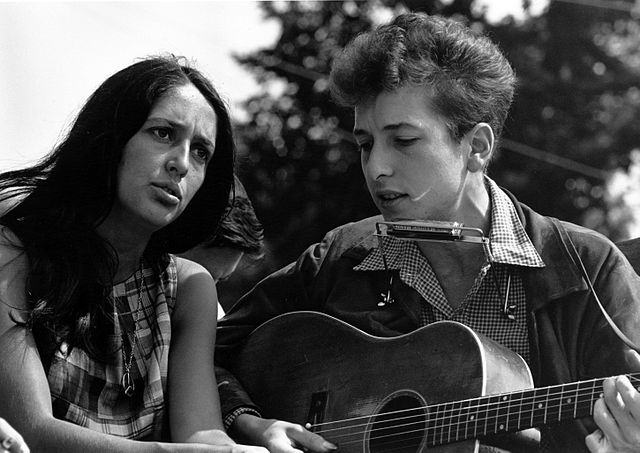Bob Dylan, in something of a surprise—though a long-speculated one—was just awarded the Nobel Prize for Literature. So expect a lot of "The Times They Are A-Changin'" puns and close-reading Dylanology about his lyrics as literature.
But perhaps spare a moment for the work of University of Chicago professor Steven Rings, whose Dylan research I've written about before. In 2013, Rings did a close musical reading of Dylan's "It's Alright, Ma (I'm Only Bleeding)" and its evolution over Dylan's long career, including his almost three-decade Never Ending Tour. It's a fascinating look at just how Dylan stuffed his broad influences into one song, even just into the first album version, and speaks to how he was able to draw such a wide audience so quickly.
Here's a refresher.
First, a quick nod to the literature. "Dylan’s writing in early 1964 also showed his growing confidence in assimilating influences from the Beats and symbolist poets like Rimbaud, replacing the forthright pieties of the protest songs with 'chains of flashing images'—surreal, allusive, and often inscrutable," Rings writes. "The lyrics are characteristically dense with intertexts, from Darkness at Noon to 'That’s All Right, Mama,' Ecclesiastes to blackface minstrelsy."
So that's heavy. But Dylan grounds it in familiar sounds, not least the ever-so-light Everly Brothers. "This might seem an implausible intertext for Dylan’s apocalyptic epic, but the
musical similarities [between 'It's Alright Ma' and 'Wake Up, Little Susie'] are too vivid to discount: the riff plays the same formal role in both songs, entering first in the opening
vamp and then returning as an emphatic punctuation after each statement of the refrain, acting as what Walter Everett calls a 'tattoo,'" Rings writes.
But the accent chords that come in after "wake up, little Susie," are sharpened into something less rockabilly and more plaintive, which is true for the song more generally. For that, Dylan turns to rural American guitar music, both white and black. "The strumming is in a rather ragged Carter-Family style, intermixing melodic fragments on the low strings with strummed chords above," Rings writes. "The vigorous tempo and attack evoke Odetta or Leadbelly, while the stabbing accented chords on the top three strings call to mind Robert Johnson."
For instance, a 1940 recording of "Gallow's Pole" by Leadbelly:
And Robert Johnson's "Preachin' Blues" (Rings quotes Dylan as writing, about Johnson, that "the stabbing sounds from the guitar could almost break a window"):
And the Carter Family's "Single Girl, Married Girl":
To this melange of Americana Dylan fuses Beat-influenced lyrics; to make the complex scheme work, he dips back into the old American music he loves. (This bit is tricky; I had to go in and count off the beats to pick up what Rings noticed.)
Chords 1 through 4 each set one line of text, the four feet of the prosody corresponding loosely to the four beats given each chord…. Chord 5, by contrast, typically lasts longer than four beats, as it sets the final two lines of the verse.
[snip]
The metric variability of chord 5 instances a familiar phenomenon in bluegrass, old-time country, and rural blues. Bluegrass musicians use the term “crooked tunes” to refer to songs or instrumental numbers in which dropped or added beats create moments of irregularity—or, as Joti Rockwell (2011) puts it, “non-isochrony”—in a given metric layer. The non-isochronous aspects of Dylan’s playing are not merely accidental—he knew of this tradition. In his copy of Woody Guthrie’s songbook From California to the New York Island, he highlighted a passage in Pete Seeger’s introduction advocating “irregularity” in performance.
Guthrie put this to use in his talking blues songs (a tradition, in the recorded sense, with roots in early country).
Dylan, of course, loved this form early in his career.
It was Dylan's genius to see how this musical foundation could underlay the Beat poetry he loved, as Sean Wilentz, one of his many biographers, writes:
Dylan’s involvement with the writings of Kerouac, Ginsberg, Burroughs, and the rest of the Beat generation is nearly as essential to Dylan’s biography as his immersion in rock and roll, rhythm and blues, and then Woody Guthrie. “I came out of the wilderness and just naturally fell in with the Beat scene, the bohemian, Be Bop crowd, it was all pretty much connected,” Dylan said in 1985. “It was Jack Kerouac, Ginsberg, Corso, Ferlinghetti … I got in at the tail end of that and it was magic … it had just as big an impact on me as Elvis Presley.”
The Beats and Elvis Presley were running on parallel tracks in the 1950s—Ginsburg read "Howl" for the first time in 1955, Elvis recorded his first single, "That's All Right," in 1954 (a cover of a 1946 Chicago blues song, "That's Alright Mama," by Arthur Crudup, which borrowed from Blind Lemon Jefferson). In 1964, by Dylan's hand, they became "That's Alright Ma (I'm Only Bleeding)."
This is all barely scratching the surface of Rings's analysis; Dylan is now in his fifth decade of playing the song, and Rings follows it forward as it evolves, from "something approaching heavy metal" in 1978 to "nimble country-blues" in the '90s, "from obtuse hipster protest to Vegas mélange, from country two-step to searing blues, often seeming to obliterate the previous iteration in its reinvention." Rings concludes that the latest iteration pushes it back to the late 19th century and early 20th century, where its roots start to gather. It's part of Dylan's self-presentation as "curator of a quasi-mythical musical past," but it's obviously not a false self.
And it's Dylan, farsighted as usual: canonizing himself shortly before the ultimate canonization.



